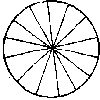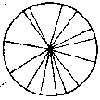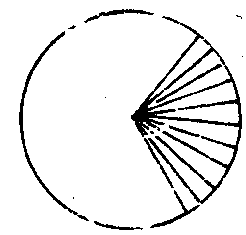
Hidden Talents and Brain Maps
Hiddentalents.org
© 2001 Stephen Holland --- sholland@softwaves.net
| 6 Types | 8 Sexes |
 Hidden Talents and Brain Maps Hiddentalents.org © 2001 Stephen Holland --- sholland@softwaves.net
|
Home | Index | Outer parts | |||||
| Input / Output | Inner parts | |||||||
| L / R Sides | Patchwork Quilt | |||||||
| Brain Maps | Print maps | |||||||
| LEFT Brain | RIGHT Brain | |||||||
| Activities | L / R Types | |||||||
| Balanced vs Expert | Men vs Women | |||||||
| Feedback | ||||||||
|
|
||||||||
| 7. Balanced or Genius? | |
The page on the "Patchwork Quilt" brain hows how the brain cortex is divided into specific patches for specific jobs or talents. However, the size, development, and even exact location of the patches varies greatly from individual to individual. This forces brain surgeons to spend much time in mapping out a person's brain with electrodes before operating on it. 1. The "Balanced" brain  Imagine a pie sliced into sections, with each section representing a talent in the brain. A person with a perfectly balanced brain, with all talents equally strong, would look like a pie with equally sized slices. The size of the pie could represent amount of talent. A super person with high levels of all talents would have a bigger total pie. Balanced, Lower talent:  Balanced, Higher Talent: Balanced, Higher Talent:  2. The "Normal" brain  Who has a "balanced brain" where all talents are equal? Almost no one! Normal people have many variations in talents. You might have strong music rhythm sense and want to dance, but with lower coordination talent you may stumble often when dancing. Your language skills may be good in grammar but weak in spelling. 3. The "Genius" brain  The genius brain tends to have one or more talents that are exceptionally large. These are usually real differences -- the people will actually be born with genetic instructions to develop some areas of the brain an extra amount. (Whether the genius talent is recognized and developed is another matter, as mentioned about Leonardo da Vinci in today's school system on the home page!) The "absent-minded professor." There is often a price to pay for being a genius. There is only so much room inside the skull for cortex, even with it folded a lot. There is a tendency for geniuses to be very strong in some talents yet noticeably weak in others. If one pie slice is extra big, then other pie slices may get sacrificed, as shown in the diagram above. Stories about Albert Einstein being absent-minded make the rest of us normal people feel a little less intimidated. Ironically, he was a genius in math talents, but was famous for his forgetfullness about time and schedules. Appropriately, he invented the theory of relativity where time was no longer very important. Where the "absent-mindedness" will show up depends upon which other talents were sacrificed to make room for the super talent. Many times it may not be anything noticeable, such as a great musician who might be weak in navigating his way around a supermarket (because most of the spatial area was devoted to musical perception rather than visual perception). However, the "Yes" creative area of the brain is often large at the expense of the lower "No" or inhibition center, producing a genius who acts "funny" or uninhibited. 4. The "Idiot-Savant" brain  Some people are occasionally born with "super-talents" such as the ability to memorize a phone book at a glance, or play a Mozart piano concert at age three. This is really an extension of the genius patttern above. Unfortunately, the sacrificed areas of low talent may render the person unable to live normal lives, so they end up in institutions. The term idiot-savant basically means dumb-smart, reflecting the talents being out of balance. (Most are males, reflecting the sex differences in the next section.) |
|
Stephen Holland --- sholland@softwaves.net